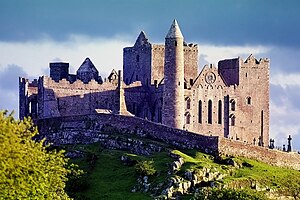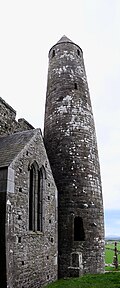Rock of Cashel
| Rock of Cashel | |
| County Tipperary | |
|---|---|
 Rock of Cashel | |
| S075409 52°31’12"N, 7°53’26"W | |
The Rock of Cashel is a hill by the town of Cashel in County Tipperary, and a site of immense historical and legendary interest. The town grew up around the rock, and is now spread out on the lower ground to its south.
The Rock is also known as 'Cashel of the Kings' and 'St Patrick's Rock'. This was anciently the seat of the Kings of Munster going back into pre-history, and later the site of the Cathedral of the Archbishops of Cashel.
Contents
History
The Rock of Cashel was the traditional seat of the Kings of Munster for several hundred years before the Norman invasion, and it is accounted one of the six main Royal Sites of Ireland. Cashel is reputed to be the site of the conversion of the King of Munster by St Patrick in the 5th century.
In 1101, the King of Munster, Muirchertach Ua Briain, donated his fortress on the Rock to the Church.
A cathedral was built on the rock, and other church buildings around it, which developed over the centuries. Ths picturesque complex has a character of its own and is one of the most remarkable collections of Celtic art and mediæval architecture to be found anywhere in Europe.[1] Few remnants of the early structures survive; the majority of buildings on the current site date from the 12th and 13th centuries. Cashel's Old Cathedral still dominates the top of the rock. It ceased to be the sear of an archbishop in 1749, when the see moved down into the town and the old cathedral was unroofed and allowed to fall into ruin.
Buildings on the Rock
The Round Tower
The oldest and tallest of the buildings is the well preserved round tower, 90 feet high and dating from c.1100. Its entrance is twelve feet from the ground, necessitated by a shallow foundation (about three feet) typical of round towers. The tower was built using the dry stone method. Modern conservationists have filled in some of the tower with mortar for safety reasons.
Cormac's Chapel
The chapel of King Cormac Mac Carthaigh, was begun in 1127 and consecrated in 1134.[1] It is a sophisticated structure, with vaulted ceilings and wide arches, drawing on contemporary European architecture and infusing unique native elements. The Irish Abbot of Regensburg, Dirmicius of Regensburg, sent two of his carpenters to help in the work and the twin towers on either side of the junction of the nave and chancel are strongly suggestive of their Germanic influence, as this feature is otherwise unknown in Ireland.
Other notable features of the building include interior and exterior arcading, a barrel-vaulted roof, a carved tympanum over both doorways, the magnificent north doorway and chancel arch. It contains one of the best-preserved Irish mediæval frescoes.
The Chapel was constructed primarily of sandstone which has become waterlogged over the centuries, significantly damaging the interior frescoes. Restoration and preservation required the chapel be completely enclosed in a rain-proof structure with interior dehumidifiers to dry out the stone.
Cashel Old Cathedral
Cashel 'Cathedral' was built between 1235 and 1270. It is an aisleless building of cruciform plan, having a central tower and terminating westwards in a massive residential castle.
The Hall of the Vicars Choral was built in the 15th century. The vicars choral were laymen (sometimes minor canons) appointed to assist in chanting the cathedral services. At Cashel, there were originally eight vicars choral with their own seal. This was later reduced to five honorary vicars choral who appointed singing-men as their deputies, a practice which continued until 1836. The restoration of the Hall was undertaken by the Office of Public Works as a project in connection with the European Architectural Heritage Year, 1975. Through it visitors now enter the site.[2]
In 1647, during the Irish Confederate Wars, Cashel was sacked by English Parliamentarian troops under Murrough O'Brien, 1st Earl of Inchiquin. The Irish Confederate troops there were massacred, as were the Roman Catholic clergy, including Theobald Stapleton. Inchiquin's troops looted or destroyed many valued religious artefacts.[1]
In 1749, the main cathedral roof was removed by Arthur Price, the Archbishop of Cashel.[2] Today, what remains of the Rock of Cashel has become a tourist attraction. Price's decision to remove the roof on what had been called the jewel among Irish church buildings was criticised before and since.[3] Proposals have been raised on occasion to reroof what is now a ruin.[4]
Queen Elizabeth II visited the Rock of Cashel during her 2011 visit to Ireland.[5]
Other features
The entire plateau on which the buildings and graveyard lie is walled. In the grounds around the buildings an extensive graveyard includes a number of high crosses. Scully's Cross, one of the largest and most famous high crosses here, originally constructed in 1867 to commemorate the Scully family, was destroyed in 1976 when lightning struck a metal rod that ran the length of the cross. The remains of the top of the cross now lie at the base of the cross adjacent to the rock wall.
Legends
According to local mythology, the Rock of Cashel originated in the Devil's Bit, a mountain twenty miles north of Cashel when St Patrick banished Satan from a cave, resulting in the Rock's landing in Cashel.[2]
Outside links
| ("Wikimedia Commons" has material about Rock of Cashel) |
- Rock of Cashel on 'Heritage Ireland'
References
- ↑ 1.0 1.1 1.2 Howitt, William (1864). Ruined abbeys and castles of Great Britain. 2. A.W. Bennett. pp. 159–161.
- ↑ 2.0 2.1 2.2 Seymour, John (1907). Records of the past. 6. Records of the Past Exploration Society. pp. 259–263.
- ↑ Rev. John Healy, LL.D, (Anglican Rector of Kells & Canon of St Patrick's, Dublin) History of the Diocese of Meath: Vol. II. (Association for Promoting Christian Knowledge; 1908) p. 93.
- ↑ 'Councillor's Ambition is to see Cashel Cathedral crowned again': The Irish Times, 21 October 1998
- ↑ "The Queen in Ireland: day four as it happened," The Telegraph https://www.telegraph.co.uk/news/uknews/queen-elizabeth-II/8517953/The-Queen-in-Ireland-day-four-as-it-happened.html





